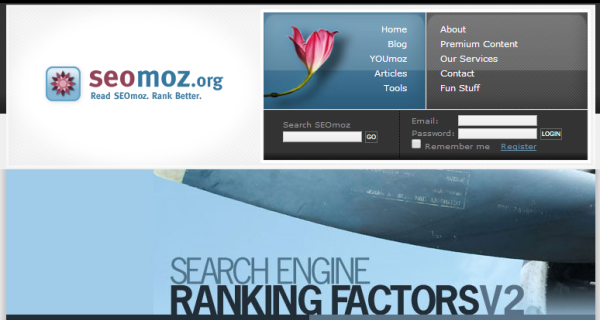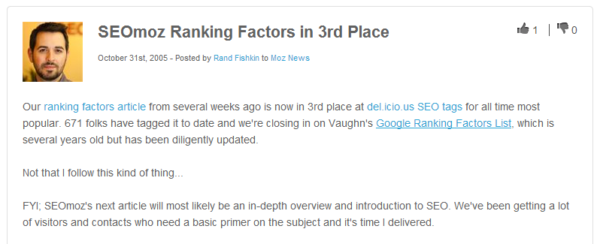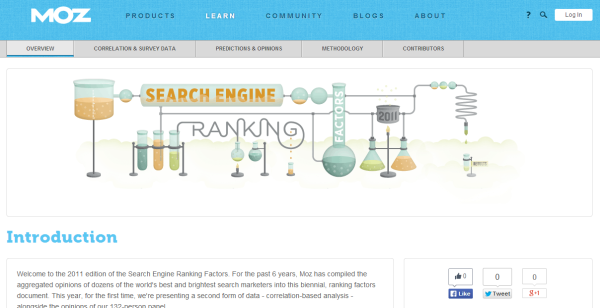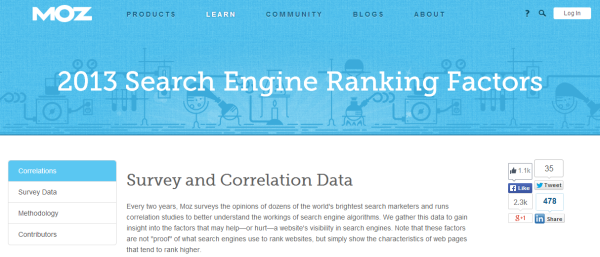How Fast Is SEO Really Changing? A Look Back At Search Ranking Factors
Ready for a walk down memory lane? The Search Ranking Factors studies by well-known SEO Rand Fishkin started in 2005, and he and his group have been churning out perceptive insights every two years ever since. If you take a look at how the findings have changed throughout the eight years that the studies have published, […]
Ready for a walk down memory lane? The Search Ranking Factors studies by well-known SEO Rand Fishkin started in 2005, and he and his group have been churning out perceptive insights every two years ever since.
If you take a look at how the findings have changed throughout the eight years that the studies have published, some interesting trends emerge. And, if you’re struggling with justifying SEO investments with the C-suite or investors, a historical perspective might be just what you need.
Quick Background
Don’t get me wrong: just one year’s study is packed with mountains of information. Attempting to summarize five studies is a daunting undertaking, so this comparison is by no means comprehensive — consider it a “highlight of highlights.”
Each study was comprised of leading SEO experts scoring the impact of a wide range of SEO factors. The exact factors studied were revised and improved every two years, so there is no true direct study-to-study comparison. I focused my time here on this survey data, not the correlation data added in 2011 and 2013.
There are a couple of risks in writing a post obsessing about Moz’s work. First, I might look like a helpless Moz poster child. I assure you that is not the case, and I am well rounded in my SEO reading habits. Second, it might look like Rand paid me for this. Ha! But he is still welcome to send compensation, you know, just in case.
Humble, Insightful Beginnings: 2005 and 2007
I was unable to find the original 2005 and 2007 Search Ranking Factors studies on Moz.com. However, with enough time on Archive.org, you can find anything. So for you SEO history buffs, here are the original SEOmoz Search Ranking Factors from 2005, and the v2 update from 2007.

SEOmoz’s very first Search Ranking Factors from 2005.

The “V2” Search Ranking Factors update from 2007.
It brought a smile to my face to see Rand celebrating 671 del.icio.us tags in 2005, closing in on Vaughn’s “diligently updated” Google Ranking Factors List. Rand can probably pull off 671 shares in about 1.5 minutes these days.

Rand celebrates 671 del.icio.us tags in 2005.
The 2005 study only included 12 contributors (plus Rand), a number which has ballooned to over 120 in 2013. However the original batch of insights are still intriguing. The most important ranking factors identified in 2005 were:
- Title Tag
- Anchor Text of Links
- Keyword Use in Document Text
- Accessibility of Document
- Links to Document from Site-Internal Pages
- Primary Subject Matter of Site
- External Links to Linking Pages
- Link Popularity of Site in Topical Community
- Global Link Popularity of Site
- Keyword Spamming (a “Detrimental Ranking Factor”)
Except for “Anchor Text of Links” in the #2 slot, all of the other top factors remain important to some degree today.
It’s still a very good idea to pay careful attention to your Title Tags, and Keyword Spamming is still a bad idea, etc. Some might consider this an encouraging observation when it feels as though “SEO keeps changing!” But even in 2005, we saw signs of the more “timeless” trends that are standing strong today: relevant content and relevant links.
The top factors in 2007 changed a bit with the addition of new, revised and more specific factors:
- Keyword Use in Title Tag
- Global Link Popularity of Site
- Anchor Text of Inbound Link
- Link Popularity within the Site’s Internal Link Structure
- Age of Site
- Topical Relevance of Inbound Links to Site
- Link Popularity of Site in Topical Community
- Keyword Use in Body Text
- Global Link Popularity of Linking Site
- Rate of New Inbound Links to Site
Link-related factors crowded the list (taken further with Wiep’s own Link Value Factors study). At a time when the SEO industry itself was still very young, with plenty of disparate ideas about what worked and what didn’t, these first studies provided helpful guidance for practitioners.
They also reinforced the reality of the time that exact-match anchor text links delivered results; but, that of course, came back to haunt many a site as Google clamped down on low-quality links in the coming years.
2009, 2011 & 2013: More Trends Emerge
The MozPlex must be proud of their studies from 2009 on because I was actually able to find all three of them still sitting happily on Moz.com.

The 2009 version of Search Ranking Factors, a.k.a. “V3.”

Search Ranking Factors 2011 study.

The most up-to-date Search Ranking Factors study from 2013.
The format of the 2009, 2011 and 2013 studies evolved considerably from their historical counterparts. 2009 was the last study to identify across-the-board top ranking factors, and this time only five were given:
- Keyword Focused Anchor Text from External Links
- External Link Popularity (quantity/quality of external links)
- Diversity of Link Sources (links from many unique root domains)
- Keyword Use Anywhere in the Title Tag
- Trustworthiness of the Domain Based on Link Distance from Trusted Domains (e.g., TrustRank, Domain mozTrust, etc.)
The findings seem to illustrate the fevered pitch that link building had reached around that time. Who wouldn’t look at these results and dump a majority of their resources into links in whatever shape or form they could get?
Domain Level Link Authority Metrics
Diving into specific aspects of link building factors reveals a few interesting trends. For instance, brand considerations were not even mentioned in 2009, even though the Vince update was announced six months prior to the study’s release. In 2011, the percentage of brand terms in a site’s link profile was the #8 domain level link authority metric, rising to #6 in 2013.
Another trend seen on the domain level is trustworthiness vs. quantity. In 2009, the trust level of inbound links was the #1 domain level link metric studied. In 2011 that dropped to #3 and in 2013 trust was still only in the #2 spot. However, in 2011, and still in 2013, participants felt that the “Quantity of unique linking domains to the domain” was and still is the most important domain link profile metric.
In a post-Penguin, penalties-for-everyone world, this finding seems almost counter intuitive. In fact, SEO Matt Gratt’s 2013 comment in the report seems to disagree with the top survey result when he said: “Google seems to be depreciating more links than ever before, so this is actually increasing the impact of getting the links that count, IMHO.”
In other news, the importance of topically-relevant links has remained relatively consistent while diversity of links has fallen from #3 in 2009 to #8 in 2011 and 2013.
Page Level Link-Based Features
How the mighty exact match anchor text has fallen! It remained in first place in both 2009 and 2011, only to drop to #13 in 2013. I was a little surprised to see it in the 2013 list at all, but it is still alive and well in the wild: we have new clients even today that are moving away from agencies that still heavily employ exact match link building across the board.
Again, we see the importance of raw popularity, with “Quantity of unique linking domains to the page” averaging in the #2 slot. The topical relevance of links has seen a noteworthy rise from #6 in 2009 and #7 in 2011 to #3 in 2013, but perhaps the most revealing trend is found in the wording of the 5 most influential factors in this category.
In 2011, all of the 5 most important page-level link factors began with the word “Quantity.” Then in 2013, the top 5 started with “Diversity,” Quantity,” “Topical relevance,” “Diversity,” and “Quantity.” Although quantity remains important, numerous other link factors are being considered as we wait to see how Hummingbird will actually change link building and whether or not links will continue to have such a predominant impact on rankings.
Social Metrics (Page Level)
This discussion isn’t complete without a look at social metrics, as well. In 2011, Twitter was clearly king, dominating the top social metrics studied. In 2013, Google+ ruled the study findings.
But apparently, we are not very good at predicting social’s impact on search. For example, in 2011, Twitter was clearly the most influential social factor according to survey participants. However, correlation data from that same study showed Facebook factors as having the most predominant impact. And of course, in 2013, many SEO experts think Google+ has a significant impact on rankings, even though Google continues to deny it.
Perhaps these two comments from 2013 illustrate the industry’s continued uncertainty over social’s current and future impact:
Hannah Smith: “Sorry – I’ve not seen any evidence that’s convinced me that page-level social metrics play a part in the algorithm.”
Todd Malicoat: “Expect Google to push for higher adoption of G+, and adopt more social signals as their network of users grows and becomes more reliable for important relevance data points.”
Uncertain Future?
Plenty of confusion remains today, especially around speculations of how social and even links will, won’t or might impact rankings. Link building used to be the stalwart tactic of the SEO world but, for some, has become the annoying song you just can’t get out of your head! But, there are larger meta trends that give a clear sign of what type of efforts — even link building efforts — will continue to pay off.
You can read a lot today about how SEO must be user-focused, and that SEO tactics must provide benefit to real people. Those ideas aren’t based on fluff, or even what gets rankings today. The search ranking factors that have stood the test of time are typically those that do, in fact, benefit real users, and we can only expect that those are the factors that will continue to deliver a return over the long haul.
The same applies to link building and earning links that matter. With this perspective of historical trends, the link building that will continue to matter is of the type that adds value for humans rather than just for algorithms.
Opinions expressed in this article are those of the guest author and not necessarily Search Engine Land. Staff authors are listed here.
Related stories